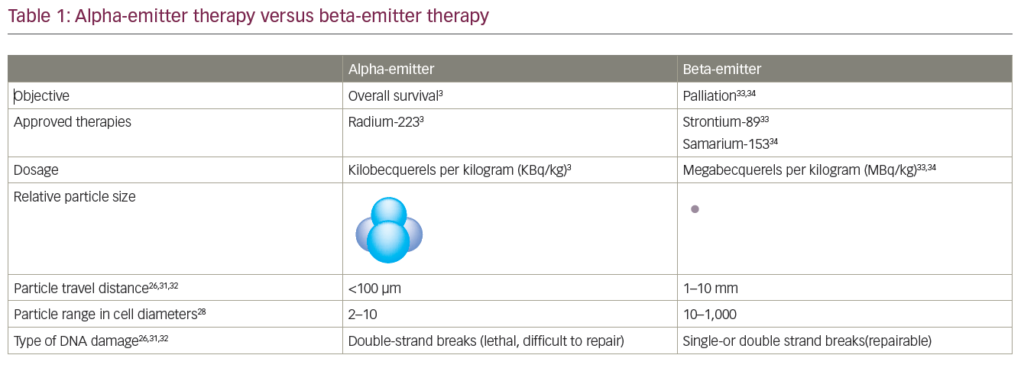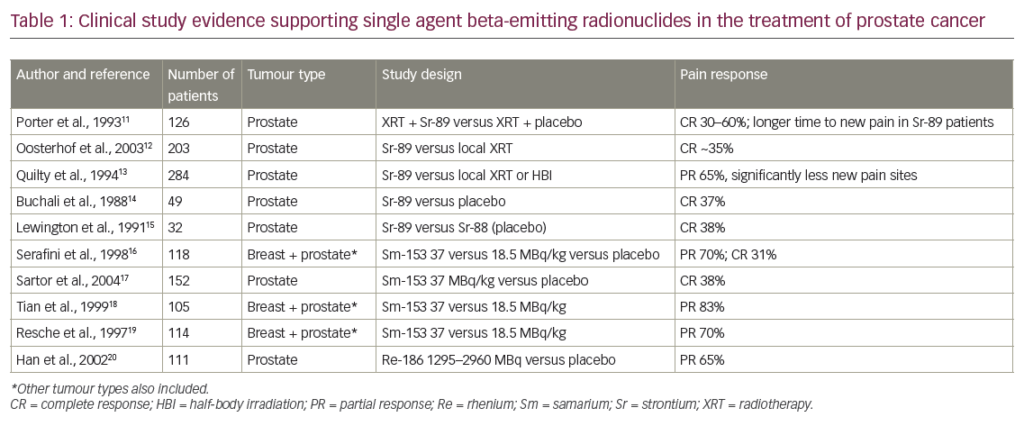Introduction
Prostate cancer is one of the most common cancers affecting men worldwide.1 Current cancer statistics estimate that more than 200,000 men are diagnosed with prostate cancer in the US each year,2 and five-year worldwide prevalence is approaching 2.5 million cases.3 Approximately 50% of patients will experience disease recurrence after local therapy consisting of radiation or prostatectomy.4 Although advances in the treatment of prostate cancer have extended life expectancy, 65% to 75% of patients with advanced disease will develop bone metastases, resulting in accelerated bone resorption and a loss of skeletal integrity that is associated with significant skeletal morbidity, including pathologic fractures, spinal cord compression, and debilitating bone pain.5
The incidence of skeletal complications experienced by patients with metastatic prostate cancer is illustrated by the placebo group of a recent study of zoledronic acid in men with hormone-refractory prostate cancer (HRPC) and bone metastases.6,7 In this study, nearly 50% of patients receiving placebo experienced = 1 skeletal complication and 33% suffered severe bone pain requiring palliative radiotherapy. A recent study showed that these skeletal complications result in significant decreases in quality-of-life scores.8 Therefore, therapies that prevent skeletal complications and reduce bone pain could translate into improvements in quality of life.
Bisphosphonates are potent inhibitors of bone resorption that have demonstrated clinical benefit for the treatment of malignant bone disease and are the standard of care for the prevention of skeletal complications in patients with bone metastases from breast cancer.9 Several studies have evaluated the efficacy of bisphosphonates – including etidronate, clodronate, pamidronate, ibandronate, and zoledronic acid – in patients with bone metastases from prostate cancer. However, until the recent trial evaluating the efficacy of zoledronic acid in men with HRPC and bone metastases, no bisphosphonate has demonstrated statistically significant long-term reductions in skeletal morbidity or durable pain reduction in this patient population in a randomized placebo-controlled trial.6
Benefit of Bisphosphonates in Advanced Prostate Cancer
Etidronate and Clodronate
Early-generation bisphosphonates including etidronate and clodronate failed to demonstrate statistically significant, durable clinical benefits in men with bone metastases secondary to prostate cancer. Although single-arm studies of oral and intravenous (IV) clodronate and etidronate demonstrated transient reductions from baseline in pain levels and analgesic use, these decreases did not reach significance.10–13 Furthermore, the clinical benefits of these agents have not been demonstrated in randomized controlled trials.14–18 In a recent randomized controlled trial involving 209 men with HRPC and bone metastases, IV clodronate (1,500mg) administered every three weeks in combination with mitoxantrone/prednisone did not significantly improve palliative response (combination of pain and analgesic scores) compared with mitoxantrone/prednisone plus placebo.17 Additionally, in a randomized controlled trial involving 311 men with metastatic prostate cancer who were receiving first-line hormonal therapy, oral clodronate (2,080mg/day) did not significantly extend bone progression-free survival, defined as the time from randomization to the development of symptomatic bone metastases or death from prostate cancer, compared with placebo, after a median of 59 months’ follow-up.18 Furthermore, the patients receiving oral clodronate experienced significantly more adverse events, particularly gastrointestinal problems, compared with placebo (risk ratio=1.71; p=0.002).
Pamidronate
Similarly, randomized studies of pamidronate in men with bone metastases from prostate cancer also failed to demonstrate clinical benefit.19,20 In a randomized openlabel trial involving 58 patients, IV pamidronate (60 or 90mg every two to four weeks) for three months reduced bone pain, but did not consistently reduce biochemical markers of bone turnover.19 In a more recent combined analysis of two multicenter, randomized placebo-controlled trials involving 374 patients with HRPC and bone metastases, IV pamidronate (90mg every three weeks) did not significantly reduce brief pain inventory (BPI) pain scores (primary end-point) or analgesic use compared with placebo after 27 weeks of treatment.20 Moreover, pamidronate failed to reduce the percentage of patients experiencing a skeletal complication compared with placebo (25% in both treatment groups at 27 weeks).
Zoledronic acid (4mg every three weeks for 24 months) significantly reduced the percentage of patients with any SRE compared with placebo at three, six, 15, and 24 months. Data from Saad et al.l6,22 and Lipton et al.;24 adapted with permission from Saad et al.25
Ibandronate
Recently, in a small, open-label study, IV ibandronate demonstrated reduction of bone pain in men with HRPC and bone metastases.21 In this trial, 25 patients were treated with ibandronate (6mg) every four weeks. All patients reported high levels of bone pain at baseline, with a mean pain score of 6.5 on a visual analog scale of 0–10. After ibandronate treatment, 23 (92%) patients reported significant reductions from baseline in pain, with a mean pain score of 2.0 (p<0.001), and nine (39%) patients were completely pain-free. In addition, ibandronate significantly reduced analgesic use in 92% of the patients. However, these results have not been confirmed in a larger randomized controlled study, a particularly important consideration in trials that use a subjective assessment such as pain control given the acknowledged ‘placebo effect’ that can occur in an open-label trial.
Zoledronic Acid
In contrast to previous bisphosphonate studies, zoledronic acid has demonstrated objective and durable reductions in skeletal morbidity and pain in patients with prostate cancer and bone metastases. In a large randomized phase III trial, 422 men with HRPC and bone metastases were randomized to zoledronic acid (4mg every three weeks via 15-minute infusion) or placebo for up to 24 months.6,22 Efficacy outcomes were assessed by evaluating the development of skeletalrelated events (SREs), defined as a pathologic fracture, spinal cord compression, radiation or surgery to bone, or change of antineoplastic therapy to treat bone pain. This composite end-point provides an objective and comprehensive assessment of treatment effect, on the basis of clinically relevant events.23 In addition, bone pain was assessed using the brief pain inventory (BPI) pain scale. Of note, patients who required strong narcotic therapy for pain control were excluded from this study.
Analysis after 24 months of treatment demonstrated that zoledronic acid (4mg) significantly decreased the percentage of patients with an SRE relative to placebo by 22% (38% versus 49% for placebo; p=0.028; see Figure 1).6,22,24,25 Moreover, zoledronic acid consistently reduced all types of SREs.7 Notably, the clinical benefit of zoledronic acid was apparent early and was maintained throughout the entire course of the trial. Zoledronic acid significantly decreased the percentage of patients who developed an SRE compared with placebo at three months (p=0.003), at six months (p=0.025), and at 15 months (p=0.021) (see Figure 1).6,22,24,25 In contrast, treatment with pamidronate for six months demonstrated no benefit compared with placebo in the percentage of patients with an SRE.20
After 24 months’ follow-up, treatment with zoledronic acid also significantly delayed the median time to first SRE by nearly six months, from 321 days in the placebo group, to 488 days for patients treated with zoledronic acid (p=0.009; see Figure 2).6,7 Additionally, zoledronic acid significantly delayed the median time to first pathologic fracture compared with placebo (median not reached by either treatment group; 25% quartile=516 days for zoledronic acid versus 321 days for placebo; p=0.020).7 Finally, a planned Andersen–Gill multiple event analysis that took into account both the incidence and timing of skeletal complications demonstrated that zoledronic acid reduced the risk of developing an SRE by 36% compared with placebo at 24 months (hazard ratio=0.640; p=0.002).6
Zoledronic acid (4mg every three weeks for 24 months) significantly delayed the median time to first SRE by more than five months. Shaded area represents difference between medians. Adapted with permission from Saad et al.27
Retrospective exploratory analyses have further demonstrated that zoledronic acid provided on-going clinical benefit throughout the entire 24-month study period. Second-event analysis showed that zoledronic acid significantly reduced the percentage of patients who developed a second SRE relative to placebo by 32% (21% versus 31% for placebo; p=0.017), significantly delayed the median time to second SRE (median not reached for zoledronic acid versus 449 days for placebo; p=0.006), and significantly reduced the risk of developing a second SRE by 40% (hazard ratio=0.601; p=0.011) compared with placebo.26 These results imply that zoledronic acid has continuing clinical benefit with long-term treatment in this patient population.
Zoledronic acid (4mg every three weeks for 24 months) consistently reduced BPI pain scores compared with placebo throughout the course of the study. *p<0.05. SD=standard deviation. Adapted with permission from Saad et al.27
In addition to analysis of SREs, BPI composite pain scores were used to assess pain responses in patients receiving zoledronic acid. Patients in both treatment groups began the study with a low mean baseline pain score of approximately two on a scale of 0–10, and 30% of patients had no pain at baseline. As expected, pain scores increased from baseline in both treatment groups. However, patients treated with zoledronic acid reported significantly smaller increases in pain scores over the duration of the trial compared with placebo.6 Betweengroup differences reached statistical significance at three months (p=0.003), nine months (p=0.030), 21 months (p=0.014), and 24 months (p=0.024) (see Figure 3).27 In addition, a recent study using survival-adjusted cumulative event analysis demonstrated that zoledronic acid significantly reduced the need for radiation to bone (which can be considered a surrogate for bone pain) by 33.2% compared with placebo at 24 months (p=0.034).28 Therefore, zoledronic acid offers durable and consistent relief of bone pain in patients with prostate cancer.
Importantly, zoledronic acid demonstrated a favorable overall safety profile. Adverse events were manageable and included mainly the flu-like symptoms common to all IV bisphosphonates (ie, fatigue, anemia,myalgia, and pyrexia); these were observed primarily after the first few infusions. Zoledronic acid also demonstrated an acceptable renal safety profile, with the risk of experiencing an increase in serum creatinine levels similar to that of placebo (hazard ratio=1.14; p=0.752).7
Conclusions
Skeletal complications resulting from bone metastases can be associated with debilitating bone pain and can negatively affect quality of life in men with advanced prostate cancer. Although several bisphosphonates have been shown to provide transient pain relief for these patients, zoledronic acid is the only bisphosphonate to significantly reduce the incidence, delay the onset of skeletal complications, and provide consistent and durable reduction of pain in a randomized placebo-controlled trial. Therefore, zoledronic acid represents an important advancement 3 in the treatment of bone metastases in patients with advanced prostate cancer. Based on this evidence, the 3rd International Consultation on Prostate Cancer developed a prostate cancer treatment algorithm that supports the use of zoledronic acid at first evidence of bone metastases.29
The role of bisphosphonate therapy in the treatment of prostate cancer patients continues to evolve. Zoledronic acid has already demonstrated the potential to prevent cancer treatment-induced bone loss and to increase bone mineral density in patients with prostate cancer receiving androgen deprivation therapy.30 Furthermore, pre-clinical data suggest that zoledronic acid may potentially prevent bone metastases and delay disease progression.31 These studies provide evidence that in the future bisphosphonates will have an important role throughout the treatment continuum for patients with prostate cancer.













